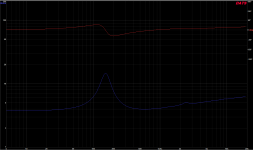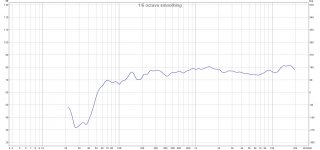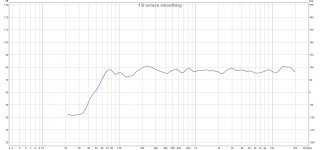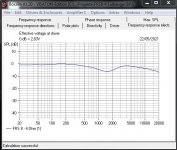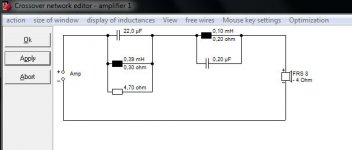Planning on trying it as a tweeter.
Should be very good. It does give the latitude to XO as much as about a decade lower than a typical tweeter.
I am currently using biig brother (A5.2eN) 240 Hz up.
I look forward to your work.
dave
...Planning on trying it as a tweeter...
Useful crossover/ equalisation. More complex than I expected. I'll have to dig in the parts box. Thanks.
Or possibly not. Don't forget Steve, EQ varies with application. One of those notches is a free space EQ of a 1.5KHz diffraction peak from a very small box intended for use close to room boundaries or on a shelf / in a bookcase. The other has been applied to the on-axis HF lift, which is partly there to help improve the top-end power response. So if you're using it as a tweeter, depending on crossover frequency you'll already be addressing any diffraction / baffle loading within the filter itself anyway (if you're crossing higher, or if using the driver's potential for lower filters, by apropriately altering the coefficients or electrical topology), and the latter is a matter of taste & intended application.
For what it's worth, the CHN50 is distantly related to the Sota 5 wideband cone tweeter which was used in the MA-Sota range of commercial speakers. I was somewhat hobbled when designing those by stipulations laid down elsewhere that I could do nothing about, but within that context, I was proud of the end result in the case of the Cesti B and particularly the Viotti One. I still have several early prototype pairs of the latter, one with a modified filter, the other with an original for slightly different balances / presentations. It was always relatively easy to cross 2nd order anywhere between about 500Hz - 3KHz depending on how much space you have for the filter in the box. If you have more room than I had you'll have the flexibility to cross with a higher order or at a lower frequency than I could (bigger / more components).
Steve, sorry they are out of stock currently, I just can't keep the bloody things on the shelf long enough. After a slowish start they are lining up to be the most popular driver I ever stocked!
I have a few pairs coming next week airmail to plug a gap but they are already spoken for. There is a pallet of driver leaving the port by sea next week as well. They are normally at sea for about 3-4 weeks although Covid and lately Brexit has messed that up a bit.
Happy to take pre orders to make sure people who are waiting can get them though.
Stefan
I have a few pairs coming next week airmail to plug a gap but they are already spoken for. There is a pallet of driver leaving the port by sea next week as well. They are normally at sea for about 3-4 weeks although Covid and lately Brexit has messed that up a bit.
Happy to take pre orders to make sure people who are waiting can get them though.
Stefan
Markaudio CHN-50 3" fullrangers arrived a couple weeks back. And pretty they are. Thank you, Stefan. 🙂
But encountered a bit of a problem for tweeter duty. The Specs are still apparently wrong!
These are 4 ohm (RE, DCR or Rvc = 3.4 ohm) drivers! 😡
CHN-50 full range driver | KJF Audio
I just have a dislike of 4 ohm impedance since it means checking if the amp can handle it. I just looked at the impedance plot and thought they must be 8 ohm nominal. Checked with multimeter and I confirm 3.4R. At 85dB I probably can't add tweeter resistors with my intended application with 89dB 8" bass. But correct me if I am wrong.
All a bit of a muddle in my mind right now. Series twinning them up would be a nuisance in existing cabinets. I am certainly smitten with the Tozzi One kit at a mere £90 plus tax and shipping. Claims to be 6 ohm nominal, but I would call that 4 ohm based on what I know.
Tozzi One self assembly speakers | KJF Audio
Even I could build that one in about half an hour:
Markaudio Tozzi one Kit build - YouTube
You may have even solved my Christmas present list for my young great-nephews. A dextrous child of 10 could build those! 😎
But am even more smitten with the Cesti B two way speaker, which I understand is 5 element second-order crossover.
Cesti B - 2 way speaker | KJF Audio
Any reason you can't give away the Cesti B crossover design and recommend suitable DIY drivers, which might be the Pluvia 11? Or something. 😕
But encountered a bit of a problem for tweeter duty. The Specs are still apparently wrong!
These are 4 ohm (RE, DCR or Rvc = 3.4 ohm) drivers! 😡
CHN-50 full range driver | KJF Audio
I just have a dislike of 4 ohm impedance since it means checking if the amp can handle it. I just looked at the impedance plot and thought they must be 8 ohm nominal. Checked with multimeter and I confirm 3.4R. At 85dB I probably can't add tweeter resistors with my intended application with 89dB 8" bass. But correct me if I am wrong.
All a bit of a muddle in my mind right now. Series twinning them up would be a nuisance in existing cabinets. I am certainly smitten with the Tozzi One kit at a mere £90 plus tax and shipping. Claims to be 6 ohm nominal, but I would call that 4 ohm based on what I know.
Tozzi One self assembly speakers | KJF Audio
Even I could build that one in about half an hour:
Markaudio Tozzi one Kit build - YouTube
You may have even solved my Christmas present list for my young great-nephews. A dextrous child of 10 could build those! 😎
But am even more smitten with the Cesti B two way speaker, which I understand is 5 element second-order crossover.
Cesti B - 2 way speaker | KJF Audio
Any reason you can't give away the Cesti B crossover design and recommend suitable DIY drivers, which might be the Pluvia 11? Or something. 😕
Last edited:
Although MA-S is largely dormant, Cesti B is still technically classed as a current commercial product, so the company haven't released the design details (I know by virtue of the fact that I designed it -I have no say over such decisions however).
The MA-S drivers are (were) the Sota 11 and Sota 5; the nearest production equivalents in the MA range are the Pluvia 11 and CHN50. Not exactly the same, but reasonably close. The small asymmetric waveguide on the latter in particular in the B was actually functional -it made a small, but measureable and audible difference.
The MA-S drivers are (were) the Sota 11 and Sota 5; the nearest production equivalents in the MA range are the Pluvia 11 and CHN50. Not exactly the same, but reasonably close. The small asymmetric waveguide on the latter in particular in the B was actually functional -it made a small, but measureable and audible difference.
I don't have a set of CHN50s here, but the attached is a Sota 5 on DATs V2 that I took a couple of years back.
I wouldn't get overly concerned about the impedance. Current draw in the higher frequencies tends to be fairly minimal, so it would have to be a very limited amplifier indeed that would struggle to drive them. Put it this way -my computer speakers are a pair of pre-production Viotti Ones, with a crossover modified to my personal tastes -they don't have a series resistor on the Sota 5 (in fact, no resistors at all) -nothing that I've put them on the end of has had any issue, output limitations notwithstanding.
I wouldn't get overly concerned about the impedance. Current draw in the higher frequencies tends to be fairly minimal, so it would have to be a very limited amplifier indeed that would struggle to drive them. Put it this way -my computer speakers are a pair of pre-production Viotti Ones, with a crossover modified to my personal tastes -they don't have a series resistor on the Sota 5 (in fact, no resistors at all) -nothing that I've put them on the end of has had any issue, output limitations notwithstanding.
Attachments
bregargasper,
I really like your speakers. Beautiful work, and I bet they sound very good.
Please help me to understand your compensation networks.
First . . . the parallel 0.1mH and 0.2uF resonates at 35.6 kHz.
Did I read your component values incorrectly?
Second . . . I think I understand the parallel 0.383mH, 22uF, and 47 Ohm resistor.
The resonant frequency is 1734Hz, and the Q is 11.3 (before it is loaded further by the driver impedance, causing the Q to be less than 11.3).
Did I analyze that network correctly?
Thanks!
I really like your speakers. Beautiful work, and I bet they sound very good.
Please help me to understand your compensation networks.
First . . . the parallel 0.1mH and 0.2uF resonates at 35.6 kHz.
Did I read your component values incorrectly?
Second . . . I think I understand the parallel 0.383mH, 22uF, and 47 Ohm resistor.
The resonant frequency is 1734Hz, and the Q is 11.3 (before it is loaded further by the driver impedance, causing the Q to be less than 11.3).
Did I analyze that network correctly?
Thanks!
Thank you sir
You are correct. I attached measurements with and without correction network. You can see two elevated areas that I tried to correct and all I really did was play around in Xsim. After all I am an electronics engineer so I believe in simulations 😀 Listening to the speakers I was amazed how well they perform. The only problem still is high frequency dispersion.First . . . the parallel 0.1mH and 0.2uF resonates at 35.6 kHz.
Did I read your component values incorrectly?
Second . . . I think I understand the parallel 0.383mH, 22uF, and 47 Ohm resistor.
The resonant frequency is 1734Hz, and the Q is 11.3 (before it is loaded further by the driver impedance, causing the Q to be less than 11.3).
Did I analyze that network correctly?
Attachments
p.s. measurements are not level matched. Still working on a setup that will allow me consistent output levels
Very helpful thread for those of us who are new to fullrangers! 🙂
It's 4.7R of course...
I had an interesting bit of serendipity with these Monacor HT22/8 closed-back cone tweeter babies:
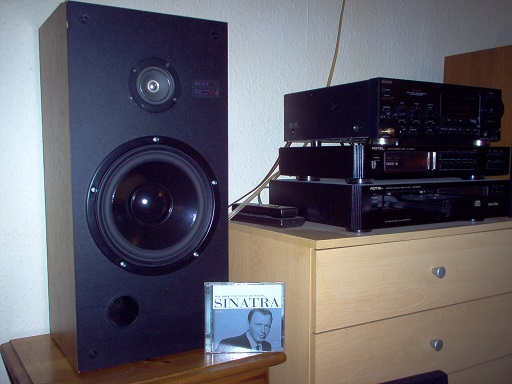
What was meant to happen was roughly this:
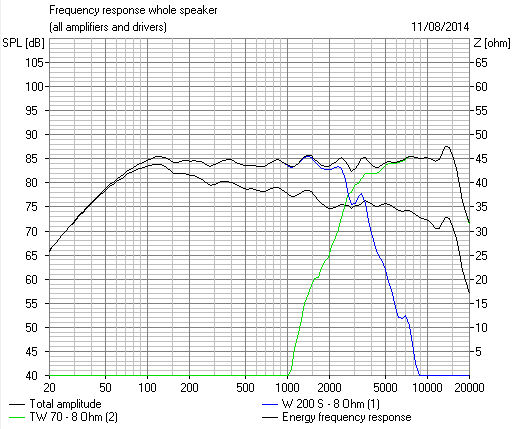
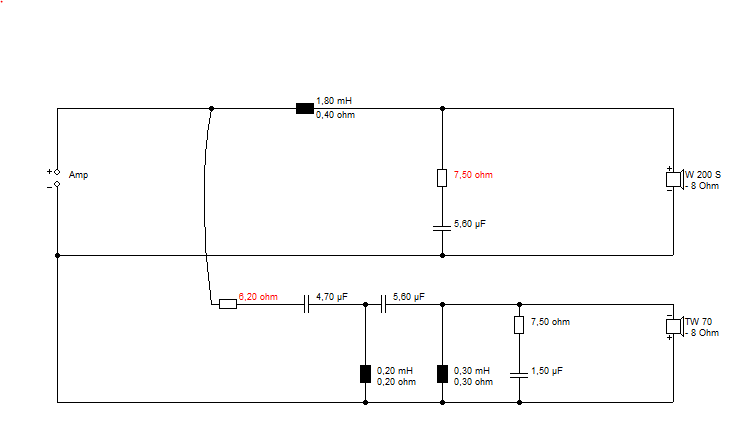
I must have been tired. I wired the 0.3mH in series, not shunt. Sounded brilliantly smooth, if a bit rolled off at the top... like a 4" paper radio speaker. 😀
Made me think a cone tweeter with a little cheap supertweeter on a simple single capacitor might work very well. Fixes the dispersion problem and might be classed a genuine first order network with all the flat-power neatness of such things.. Mike Chua has tried this sort of thing:
Swallow – a Time and Phase Coherent Satellite – AmpsLab
bregargasper,
I really like your speakers. Beautiful work, and I bet they sound very good.
Please help me to understand your compensation networks.
First . . . the parallel 0.1mH and 0.2uF resonates at 35.6 kHz.
Did I read your component values incorrectly?
Second . . . I think I understand the parallel 0.383mH, 22uF, and 47 Ohm resistor.
The resonant frequency is 1734Hz, and the Q is 11.3 (before it is loaded further by the driver impedance, causing the Q to be less than 11.3).
Did I analyze that network correctly?
Thanks!
It's 4.7R of course...
I had an interesting bit of serendipity with these Monacor HT22/8 closed-back cone tweeter babies:
What was meant to happen was roughly this:
I must have been tired. I wired the 0.3mH in series, not shunt. Sounded brilliantly smooth, if a bit rolled off at the top... like a 4" paper radio speaker. 😀
Made me think a cone tweeter with a little cheap supertweeter on a simple single capacitor might work very well. Fixes the dispersion problem and might be classed a genuine first order network with all the flat-power neatness of such things.. Mike Chua has tried this sort of thing:
Swallow – a Time and Phase Coherent Satellite – AmpsLab
system7,
Thanks for answering my question regarding the Q of the 1734 Hz network
4.7 Ohms seems more like what it should be, just as you said.
As is so often, the picture and schematic files on these posts have so poor resolution,
I could not see the period between the 4 and the 7.
However, nobody answered my question about the 0.1mH and 0.2uF parallel resonator . . .
That is 35.6 kHz, far above most tweeter's response, and far above most of our ears response.
???
Thanks for answering my question regarding the Q of the 1734 Hz network
4.7 Ohms seems more like what it should be, just as you said.
As is so often, the picture and schematic files on these posts have so poor resolution,
I could not see the period between the 4 and the 7.
However, nobody answered my question about the 0.1mH and 0.2uF parallel resonator . . .
That is 35.6 kHz, far above most tweeter's response, and far above most of our ears response.
???
My simulator only goes up to 20kHz, as do the driver files.
L-C Filter Equations
You are right the notch is at 35.6kHz however.
In practice parallel LC traps are inductive below resonance and capacitative above, And blocking or notching at resonance.
The sim reveals that a simple inductor does much the same thing as a trap up to 20kHz on a similar fullranger. The dotted line is the coil on its own.
L-C Filter Equations
You are right the notch is at 35.6kHz however.
In practice parallel LC traps are inductive below resonance and capacitative above, And blocking or notching at resonance.
The sim reveals that a simple inductor does much the same thing as a trap up to 20kHz on a similar fullranger. The dotted line is the coil on its own.
Attachments
p.s. measurements are not level matched. Still working on a setup that will allow me consistent output levels
How big is your listening room and how far from the speakers are you listening?
Well it depends. I made these speakers for my bedroom which is rougly 3x3m. They are currently used as fullrange speakers combined with 8" Mivoc woofers crossed over at 200Hz in much larger room (not the best setup I must admit). They image okay and present vocals really nicely but lack midbass enrgy, though they work well as long as I am about 1-1.5m away.
- Home
- Loudspeakers
- Full Range
- Markaudio CHN-50 small bookshelf
